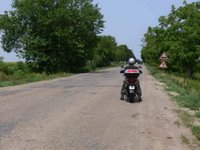 Oradea - Satu Mare - Zalau - Cluj-Napoca - Huedin
Oradea - Satu Mare - Zalau - Cluj-Napoca - HuedinParalleling the Hungarian border with continuous views of the Romanian plains, the road from Oradea to Satu Mare proved an uneventful ride. In addition, the poor quality road made the trip seem even longer than the 130 kilometers (about 80 miles) shown on the map.
 Although this route is a national highway connecting the Banat region with Maramures, we were not surprised to again see horse-drawn carts. Over the past few months, this has been an interesting experience. Romania is truly a country of contrasts. On one hand, the past is very much alive in the customs, habits and daily realities, such as horse-drawn carts--people use them here as you would use a pick-up truck to haul things or people. On the other hand, the fast-paced 21st century life is pushing for space on the very same dimension--commercial trucks blowing by constantly (and if you think that 18-wheelers feel big on an interstate, imagine them on nothing but two-lane narrow roads), delivery vans with always-impatient drivers seemingly racing one another, and overtly smug businessmen in their Porsche Cayennes, Mercedes, or BMWs flashing headlights, honking horns, and generally buying into the marketing of their overpriced cars which tells them that they "own the road."
Although this route is a national highway connecting the Banat region with Maramures, we were not surprised to again see horse-drawn carts. Over the past few months, this has been an interesting experience. Romania is truly a country of contrasts. On one hand, the past is very much alive in the customs, habits and daily realities, such as horse-drawn carts--people use them here as you would use a pick-up truck to haul things or people. On the other hand, the fast-paced 21st century life is pushing for space on the very same dimension--commercial trucks blowing by constantly (and if you think that 18-wheelers feel big on an interstate, imagine them on nothing but two-lane narrow roads), delivery vans with always-impatient drivers seemingly racing one another, and overtly smug businessmen in their Porsche Cayennes, Mercedes, or BMWs flashing headlights, honking horns, and generally buying into the marketing of their overpriced cars which tells them that they "own the road."Satu Mare was our first glimpse of Maramures. With
 the crossing of the Somes River, we began exploring the town. Based on what a travel book described as “the ugliest town in all of Romania,” we were sure that the town would not be worthy of our visit. After an initial glance on the outskirts of town, we were almost ready to write off the center, yet decided to check for ourselves this statement. As it turned out, the downtown area was fairly charming and pleasant. As a matter of fact, we have seen towns in
the crossing of the Somes River, we began exploring the town. Based on what a travel book described as “the ugliest town in all of Romania,” we were sure that the town would not be worthy of our visit. After an initial glance on the outskirts of town, we were almost ready to write off the center, yet decided to check for ourselves this statement. As it turned out, the downtown area was fairly charming and pleasant. As a matter of fact, we have seen towns in  Romania that would be much better candidates for the ‘ugliest town’ moniker. We now suspect that perhaps the writers of the misleading book (which shall remain unnamed for now) didn’t really visit this town or had a particular bone to pick with it. The Hotel Dacia was the former city hall and royal court. Much of the activity of Satu Mare is centered around the Piata Libertatii with the Hungarian Reformed, Orthodox and Roman Catholic Churches as well as the Great Synagogue nearby.
Romania that would be much better candidates for the ‘ugliest town’ moniker. We now suspect that perhaps the writers of the misleading book (which shall remain unnamed for now) didn’t really visit this town or had a particular bone to pick with it. The Hotel Dacia was the former city hall and royal court. Much of the activity of Satu Mare is centered around the Piata Libertatii with the Hungarian Reformed, Orthodox and Roman Catholic Churches as well as the Great Synagogue nearby.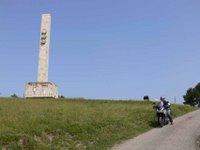
Enroute to Zalau, we took a narrow, steep hill off the main highway to the Mihai Viteazu monument. This monument celebrates the prince’s successful unification of the three historical provinces—Transylvania, Wallachia and Moldova—into one nation, albeit for a very short time, as he literally lost his head at the hands of enemies. The monument was erected in 1976, in the blocky and somewhat uninspiring style of communist monuments.
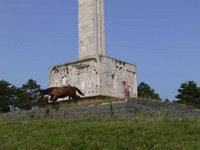
The impressive thing about it is its location—up on a hill, high above the surrounding valleys, visible for miles and miles in all directions. Equally striking were the wild horses grazing near the monument and the two herdsmen. Needless to say, the views were breathtaking and worth the awkward climb up a narrow one-lane road.
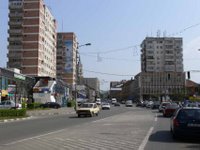
Arriving into Zalau, we were greeted with congestion and blocks at every corner. In its current format, the town is a far cry from its origins as the first documented Transylvanian town, also known in antiquity as a Roman-Dacian military and cultural stronghold.
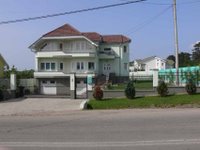 On the outskirts of Zalau toward the ascent into the mountains, we captured a surge of new home construction. But more importantly, the road provided a surprise - excellent hairpin turns! We were not
On the outskirts of Zalau toward the ascent into the mountains, we captured a surge of new home construction. But more importantly, the road provided a surprise - excellent hairpin turns! We were not 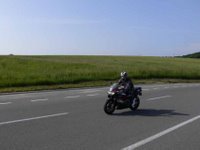 surprised to encounter a handful of sport bikes thoroughly enjoying the road weaving through the Meses Mountains into Cluj-Napoca!
surprised to encounter a handful of sport bikes thoroughly enjoying the road weaving through the Meses Mountains into Cluj-Napoca! With a bustling center, Cluj-Napoca has a vibrant personality and energy with its trendy coffee shops, swanky bars and up-to-the-minute Euro fashion on the streets. Cluj is as much Hungarian (Kolozsvar) as Romanian. In the 1970s, Ceausescu added Napoca to the city’s name to signify its Daco-Roman roots. However, most people refer to the city as Cluj. It is home to the popular Romanian beer, Ursus.
With a bustling center, Cluj-Napoca has a vibrant personality and energy with its trendy coffee shops, swanky bars and up-to-the-minute Euro fashion on the streets. Cluj is as much Hungarian (Kolozsvar) as Romanian. In the 1970s, Ceausescu added Napoca to the city’s name to signify its Daco-Roman roots. However, most people refer to the city as Cluj. It is home to the popular Romanian beer, Ursus.
One of the premier examples of Gothic architecture in Romania is the 14th century St. Michael’s Church in Cluj’s Piata Unirii. Nearby is ths statue of Matthias Corvinus (1902) who was the king of Hungary from 1458 to 1490.
Our evening ride back into Oradea was a pleasant ride with amazing roads and plenty of hairpin curves to complete the day. With the sun setting, we passed through the villages of Huedin, Ciucea and Negreni, experiencing the transforming beauty of rural Romania.
Huedin is the main area to start exploring the nearby natural wonders—mountains, caves, and waterfalls. Ciucea is a place dear to Romanians and Hungarians, as it was home to Romanian poet and politician, Octavian Goga and Hungarian poet, Ady Endre. Negreni claims to boast a fabulous Saturday fleamarket.
After another long riding day, we were happily greeted by the children of Caminul Felix Villages eagerly wanting to hear all about our day’s adventures as well as a bed at the Noble House Hotel and even dinner leftovers! – BGR & HSR

No comments:
Post a Comment